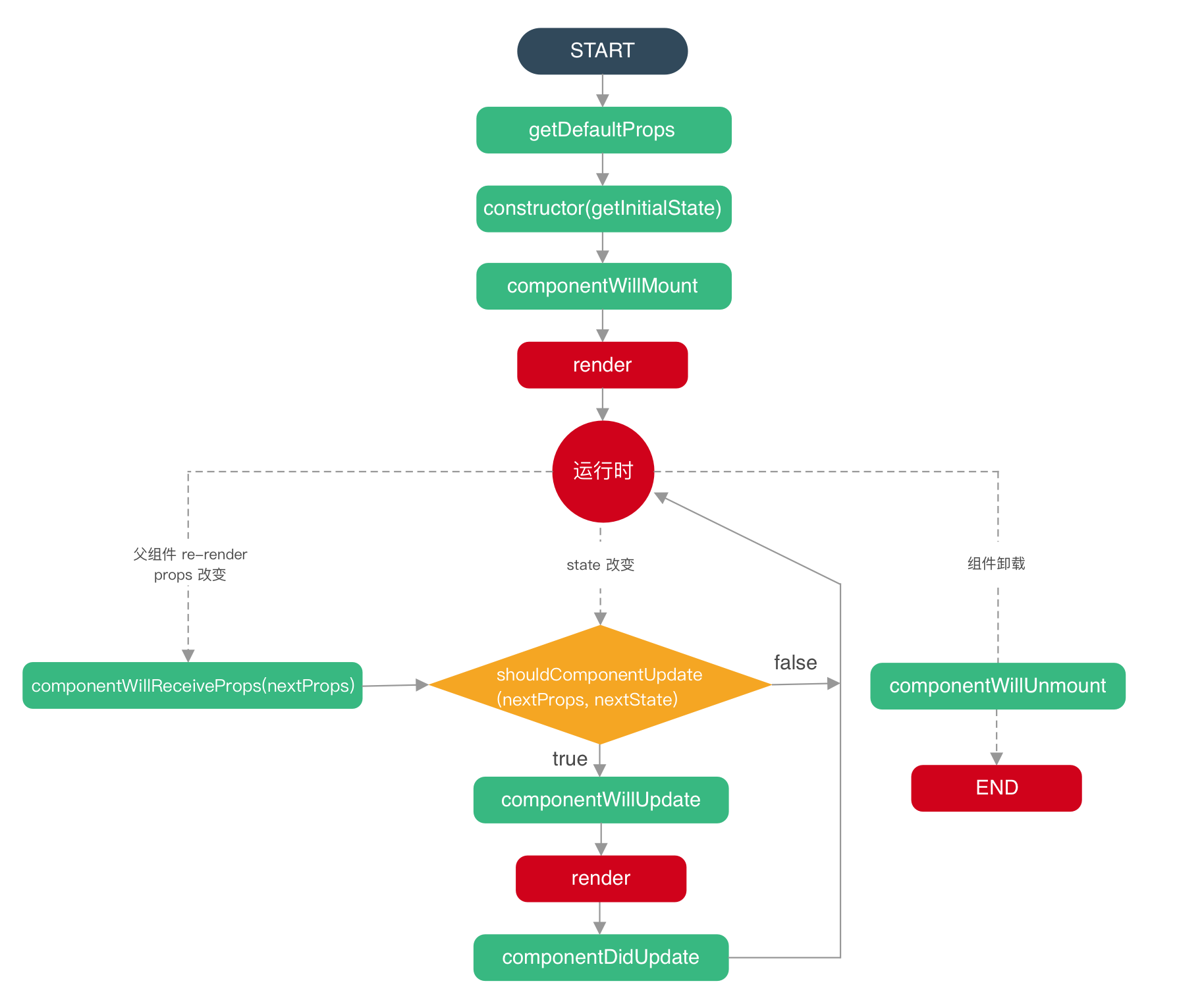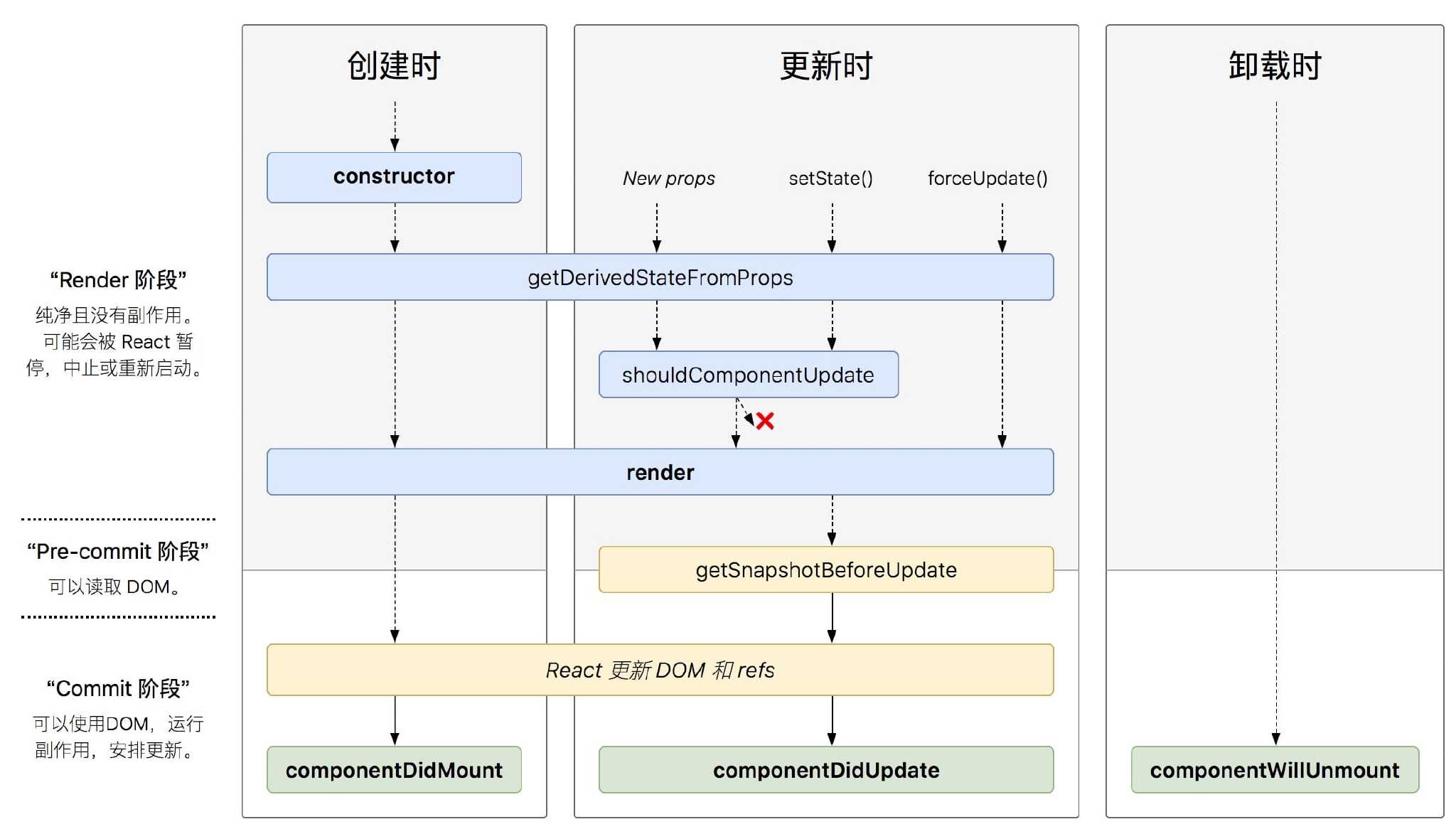前言
React 从 v16 开始,像是跨入了新的时代,性能和新的 API 都令人瞩目。重新认识 React,从重新认识生命周期开始。
为了更好的支持异步渲染(Async Rendering),解决一些生命周期滥用可能导致的问题,React 从 V16.3 开始,对生命周期进行渐进式调整,同时在官方文档也提供了使用的最佳实践。
这里我们将简要对比 React 新旧生命周期,重新认识一下 React 生命周期。
新的生命周期
先看看两张经典的生命周期的示意图

React 16.3 新增的生命周期方法
- getDerivedStateFromProps()
- getSnapshotBeforeUpdate()
逐渐废弃的生命周期方法:
- componentWillMount()
- componentWillReceiveProps()
- componentWillUpdate()
虽然废弃了这三个生命周期方法,但是为了向下兼容,将会做渐进式调整。(详情见#12028)
V16.3 并未删除这三个生命周期,同时还为它们新增以 UNSAFE_ 前缀为别名的三个函数UNSAFE_componentWillMount()、UNSAFE_componentWillReceiveProps()、UNSAFE_componentWillUpdate()。
在 16.4 版本给出警告将会弃用componentWillMount()、componentWillReceiveProps()、componentWillUpdate()三个函数
然后在 17 版本将会删除componentWillMount()、componentWillReceiveProps()、componentWillUpdate()这三个函数,会保留使用UNSAFE_componentWillMount()、UNSAFE_componentWillReceiveProps()、UNSAFE_componentWillUpdate()
一般将生命周期分成三个阶段:
- 创建阶段(Mounting)
- 更新阶段(Updating)
- 卸载阶段(Unmounting)
从 React v16 开始,还对生命周期加入了错误处理(Error Handling)。
下面分析一下生命周期的各个阶段。
创建阶段 Mounting
组件实例创建并插入 DOM 时,按顺序调用以下方法:
- constructor()
- static getDerivedStateFromProps()
componentWillMount()/UNSAFE_componentWillMount()(being deprecated)- render()
- componentDidMount()
有定义
getDerivedStateFromProps时,会忽略componentWillMount()/UNSAFE_componentWillMount()
(详情查看源码)
constructor()
1 | constructor(props) |
构造函数通常用于:
- 使用
this.state来初始化state - 给事件处理函数绑定
this
注意:ES6 子类的构造函数必须执行一次 super()。React 如果构造函数中要使用 this.props,必须先执行 super(props)。
static getDerivedStateFromProps()
1 | static getDerivedStateFromProps(nextProps, prevState) |
当创建时、接收新的 props 时、setState 时、forceUpdate 时会执行这个方法。
注意:v16.3 setState 时、forceUpdate 时不会执行这个方法,v16.4 修复了这个问题。
这是一个 静态方法,参数 nextProps 是新接收的 props,prevState 是当前的 state。返回值(对象)将用于更新 state,如果不需要更新则需要返回 null。
下面是官方文档给出的例子
1 | class ExampleComponent extends React.Component { |
这个方法的常用作用也很明显了:父组件传入新的 props 时,用来和当前的 state 对比,判断是否需要更新 state。以前一般使用 componentWillReceiveProps 做这个操作。
这个方法在建议尽量少用,只在必要的场景中使用,一般使用场景如下:
- 无条件的根据
props更新state - 当
props和state的不匹配情况更新state
详情可以参考官方文档的最佳实践 You Probably Don’t Need Derived State
componentWillMount()/UNSAFE_componentWillMount()(弃用)
1 | UNSAFE_componentWillMount() |
这个方法已经不推荐使用。因为在未来异步渲染机制下,该方法可能会多次调用。它所行使的功能也可以由 componentDidMount() 和 constructor() 代替:
- 之前有些人会把异步请求放在这个生命周期,其实大部分情况下都推荐把异步数据请求放在
componentDidMount()中。 - 在服务端渲染时,通常使用
componentWillMount()获取必要的同步数据,但是可以使用constructor()代替它。
可以使用 setState,不会触发 re-render
render
1 | render() |
每个类组件中,render() 唯一必须的方法。
render() 正如其名,作为渲染用,可以返回下面几种类型:
- React 元素(React elements)
- 数组(Arrays)
- 片段(fragments)
- 插槽(Portals)
- 字符串或数字(String and numbers)
- 布尔值或 null(Booleans or null)
注意:
Arrays 和 String 是 v16.0.0 新增。
fragments 是 v16.2.0 新增。
Portals 是 V16.0.0 新增。
里面不应该包含副作用,应该作为纯函数。
不能使用 setState。
componentDidMount()
1 | componentDidMount() |
组件完成装载(已经插入 DOM 树)时,触发该方法。这个阶段已经获取到真实的 DOM。
一般用于下面的场景:
- 异步请求 ajax
- 添加事件绑定(注意在
componentWillUnmount中取消,以免造成内存泄漏)
可以使用 setState,触发re-render,影响性能。
更新阶段 Updating
componentWillReceiveProps()/UNSAFE_componentWillReceiveProps()(being deprecated)- static getDerivedStateFromProps()
- shouldComponentUpdate()
componentWillUpdate()/UNSAFE_componentWillUpdate()(being deprecated)- render()
- getSnapshotBeforeUpdate()
- componentDidUpdate()
有
getDerivedStateFromProps或者getSnapshotBeforeUpdate时,componentWillReceiveProps()/UNSAFE_componentWillReceiveProps()和componentWillUpdate()/UNSAFE_componentWillUpdate()不会执行 (详情查看源码)
componentWillReceiveProps()/UNSAFE_componentWillReceiveProps()(弃用)
1 | UNSAFE_componentWillReceiveProps(nextProps) |
这个方法在接收新的 props 时调用,需要注意的是,如果父组件导致组件重新渲染,即使 props 没有更改,也会调用此方法。
一般用这个方法来判断 props 的前后变化来更新 state,如下面的例子:
1 | class ExampleComponent extends React.Component { |
这个方法将被弃用,推荐使用 getDerivedStateFromProps 代替。
可以使用 setState
static getDerivedStateFromProps()
同 Mounting 时所述一致。
shouldComponentUpdate()
在接收新的 props 或新的 state 时,在渲染前会触发该方法。
该方法通过返回 true 或者 false 来确定是否需要触发新的渲染。返回 false, 则不会触发后续的 UNSAFE_componentWillUpdate()、render() 和 componentDidUpdate()(但是 state 变化还是可能引起子组件重新渲染)。
所以通常通过这个方法对 props 和 state 做比较,从而避免一些不必要的渲染。
PureComponent 的原理就是对
props和state进行浅对比(shallow comparison),来判断是否触发渲染。
componentWillUpdate()/UNSAFE_componentWillUpdate() (弃用)
1 | UNSAFE_componentWillUpdate(nextProps, nextState) |
当接收到新的 props 或 state 时,在渲染前执行该方法。
在以后异步渲染时,可能会出现某些组件暂缓更新,导致 componentWillUpdate 和 componentDidUpdate 之间的时间变长,这个过程中可能发生一些变化,比如用户行为导致 DOM 发生了新的变化,这时在 componentWillUpdate 获取的信息可能就不可靠了。
不能使用 setState
render()
同 Mounting 时所述一致。
getSnapshotBeforeUpdate()
1 | getSnapShotBeforeUpdate(prevProps, prevState) |
这个方法在 render() 之后,componentDidUpdate() 之前调用。
两个参数 prevProps 表示更新前的 props,prevState 表示更新前的 state。
返回值称为一个快照(snapshot),如果不需要 snapshot,则必须显示的返回 null —— 因为返回值将作为 componentDidUpdate() 的第三个参数使用。所以这个函数必须要配合 componentDidUpdate() 一起使用。
这个函数的作用是在真实 DOM 更新(componentDidUpdate)前,获取一些需要的信息(类似快照功能),然后作为参数传给 componentDidUpdate。例如:在 getSnapShotBeforeUpdate 中获取滚动位置,然后作为参数传给 componentDidUpdate,就可以直接在渲染真实的 DOM 时就滚动到需要的位置。
下面是官方文档给出的例子:
1 | class ScrollingList extends React.Component { |
componentDidUpdate()
1 | componentDidUpdate(prevProps, prevState, snapshot) |
这个方法是在更新完成之后调用,第三个参数 snapshot 就是 getSnapshotBeforeUpdate 的返回值。
正如前面所说,有 getSnapshotBeforeUpdate 时,必须要有 componentDidUpdate。所以这个方法的一个应用场景就是上面看到的例子,配合 getSnapshotBeforeUpdate 使用。
可以使用 setState,会触发 re-render,所以要注意判断,避免导致死循环。
卸载阶段 Unmounting
- componentWillUnmount()
componentWillUnmount
1 | componentWillUnmount() |
在组件卸载或者销毁前调用。这个方法主要用来做一些清理工作,例如:
- 取消定时器
- 取消事件绑定
- 取消网络请求
不能使用 setState
错误处理 Error Handling
- componentDidCatch()
componentDidCatch()
1 | componentDidCatch(err, info) |
任何子组件在渲染期间,生命周期方法中或者构造函数 constructor 发生错误时调用。
错误边界不会捕获下面的错误:
- 事件处理 (Event handlers) (因为事件处理不发生在 React 渲染时,报错不影响渲染)
- 异步代码 (Asynchronous code) (e.g. setTimeout or requestAnimationFrame callbacks)
- 服务端渲染 (Server side rendering)
- 错误边界本身(而不是子组件)抛出的错误
总结
React 生命周期可以查看 生命周期图
虽然 React 有做向下兼容,但是推荐尽量避免使用废弃的生命周期,而是拥抱未来,用新的生命周期替换它们。
如果你不想升级 React,但是想用新的生命周期方法,也是可以的。使用 react-lifecycles-compat polyfill,可以为低版本的 React(0.14.9+)提供新的生命周期方法。
- 本文链接: https://blog.hhking.cn/2018/09/18/react-lifecycle-change/
- 版权声明: 本博客所有文章除特别声明外,均采用 BY-NC-SA 许可协议。转载请注明出处!

